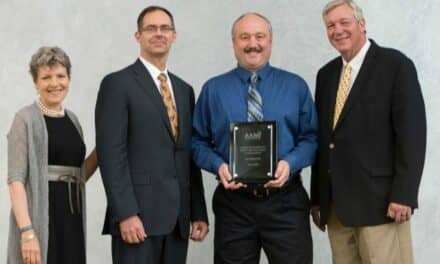By Joie N. Marhefka, PhD
I was asked to write about how to recruit people—particularly women—to the HTM field. Finding motivation for this is easy, and the need to increase the number of women in HTM is twofold: First, we simply need more qualified candidates entering the field.
As much of the HTM workforce nears retirement age (I’ve heard predictions of up to 50% of current BMETs retiring in the next decade or so) and the healthcare market continues to expand, I’ve seen estimates of roughly 5,000 BMET jobs that will need to be filled in the next three to five years. This, combined with the number of schools closing their programs in recent years, is creating a significant shortage of qualified candidates to fill BMET positions.
Currently, the vast majority of HTM professionals are men. In the few years that I have been teaching at Penn State New Kensington (PSNK), more than 30 students have graduated from our biomedical engineering technology program, and only three have been women. I find a similar ratio of men to women working in the clinical engineering departments of various local hospitals. Increasing the number of females entering the profession would go a long way toward alleviating the troubles with finding qualified candidates to fill positions. In addition, creating a more diverse workplace where diverse teams have diverse skill sets will best serve a diverse population.
In general, women and men bring different strengths and perspectives to the workplace, which can lead to an increase in productivity. The more challenging part is how to recruit more females to enter the HTM field.
One simple step is to create advertising materials showing diversity. At PSNK we are working to update the pictures in our halls, outreach presentations, and flyers to show our female as well as male alumni and students. AAMI does a good job of illustrating diversity on their website and in their videos, posters, and brochures. However, this is something that we can all do to help build an identity and show that women are welcome when recruiting for our school programs, hospitals, and companies in the HTM field.
We can also be cognizant of how we talk about HTM when doing outreach, especially when talking to young people in middle and high schools. Emphasizing aspects of the job, such as being part of the healthcare team and ultimately helping patients, in addition to traditional BMET skills like troubleshooting electronics, may make the field more attractive to females.
Wati Kumwenda, one of our recent female alumni, said this regarding what she enjoys about working in HTM: “What I love about the HTM field is the immense job satisfaction I get from day-to-day work. I really enjoy challenging myself and finding ways to resolve various equipment issues. It has taught me to be open to learning and discovering new things within the field. I equally enjoy the customer service aspect of this position. It allows me to work alongside people with different professional backgrounds and expand my knowledge of the equipment and other areas I might be unfamiliar with.”
In general, when recruiting both males and females, talking about the big picture and the vital role of BMETs in healthcare can be as important as describing daily tasks.
Perhaps we can borrow some strategies from the Carnegie Mellon computer science department, which has made a conscious effort to increase the numbers of females in the major and recently published a book on the subject, “Kicking Butt in Computer Science: Women in Computing at Carnegie Mellon University” by Carol Frieze and Jeria Quesenberry. In recent years, its female enrollment has well exceeded the national average. This was accomplished by making changes in the culture, not in the curriculum.
Briefly, the program created opportunities for female students to have access to the same things that male students have always had, including mentors, networks, role models, opportunities for professional advancement, and friends in their major. A similar, concentrated effort could help with recruiting and retaining women in HTM.
Finding a Mentor
The benefits of role models, mentors, and allies (regardless of gender) cannot be overlooked. More specifically, having female role models can improve a woman’s sense of belonging in the field, which is key in both recruitment and retention efforts. AAMI has a formal mentoring program, and mentors can also be found through school alumni associations, local HTM societies, and mutual contacts.
While mentors can be male or female, women are often most comfortable asking another woman for advice—especially one who has had similar experiences. On our college campus, we can create opportunities for female BET students to build relationships with each other, as well as female alumni and other women working in the field. Helping young women to find appropriate mentors as they prepare to enter the HTM field will support them as they begin their careers and enable them to thrive.
Finally, we must not ignore the elephant in the room. When people who are considering entering the field are given the opportunity to tour or shadow in clinical engineering departments, it is likely they will only see male technicians. We cannot ignore this. Talking about what we are doing to change the fact that the HTM field has so few women and how women’s skills can be beneficial in a clinical engineering department are steps in the direction of a more diverse workplace.
Overall, taking steps such as these to make women feel welcome in a traditionally male field and working to create a more inclusive community will go a long way toward alleviating the shortage of qualified candidates to fill BMET jobs. It will also create a more diverse workplace, which can utilize varied strengths and perspectives to increase productivity and better serve the diverse population.
Joie N. Marhefka, PhD, is assistant teaching professor and biomedical engineering technology program coordinator at Penn State New Kensington in Western Pennsylvania. Questions and comments can be directed to 24×7 Magazine chief editor Keri Forsythe-Stephens at [email protected]





excellent article. we have started a new program at our Community college in collaboration with the Hospital System I also work at, I asked this exact question at the AAMI conference I just attended and got some excellent advice. I Would like to have further conversations with either of you about this subject and the general Biomed Education field.
Thanks, Joe. I’d be happy to further discuss this topic and biomed education in general. ~Joie